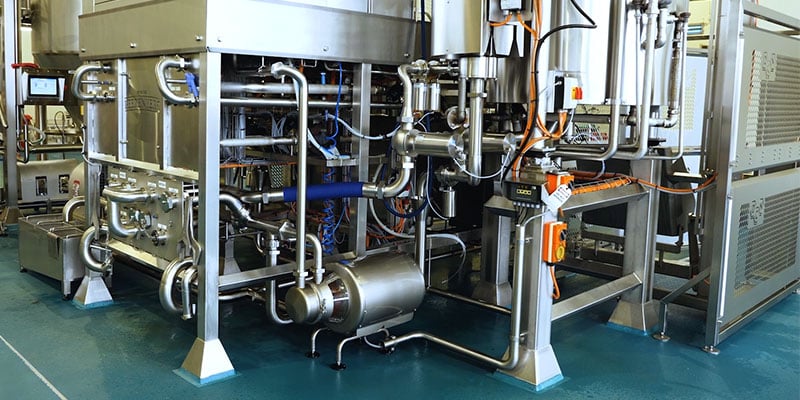When it comes to selecting the right food and beverage pump, it is imperative that the pump chosen is compliant, and most importantly, appropriate for the application. If not, you will not only be wasting delicious product, but time and money.
 Pumping system on-site at Beerenberg, South Australia
Pumping system on-site at Beerenberg, South Australia
As proper ingredient transfer is crucial in ensuring optimal efficiency and high-quality product, your pump selection should be a top priority.
Consider the following as you select the right pumping system:
- flow rate: a pump that is too small for the application will run too hard or too hot, which may cause the pump to fail. A pump that is too large will incur higher costs for purchase and operation. As a rule, pumps should operate at 30%-60% of maximum capacity. Running at this capacity reduces unnecessary wear due to high speeds and allows for future expansion if required.
- product characteristics: to ensure the pump can handle the fluids, it’s crucial that the following product elements are considered:
1. viscosity: fluid viscosity is one of the most concerning characteristics to pump operators. As the viscosity increases, the pump performance decreases. The material viscosity will affect how well the pump can load material into the inlet, as well as the outlet. Commonly, for those fluids which are high in viscosity, electric or pneumatic diaphragm pumps and peristaltic hose pumps are suggested.
2. abrasion: abrasive material can wear out pump components easily, particularly when utilising centrifugal-style pumps. Material with high sugar content can wear parts out quickly as well. Lobe pumps are sometimes coated to properly handle abrasive goods, however diaphragm pumps, handle such abrasive materials much easier.
3. material shear: diaphragm and peristaltic hose pumps are gentle on the materials they are pumping and will not damage it. Whereas centrifugal, lobe, twin screw or other rotary-style pumps may. This consideration is crucial for users whose products are affected by shear and heat - and can cause damage to the final product.
4. particle size: the particle size can dramatically influence the pump selection. Diaphragm pumps and peristaltic pumps are constructed to handle solids, whilst rotary pumps can handle some solids but not of significant size.
- construction materials: for the pump to last, it is crucial that the materials of construction are compatible with the ingredients being transferred. Most food and beverage pumps are constructed from stainless steel to comply with food standards.
It is also important to consider the cleaning solutions used at your facility. Faults may occur when a pump or seal is compatible with the food ingredients, but not with the caustics used to clean the equipment.
- approval requirements: what sort of requirements or compliance does the pump need to have? It is crucial that you ensure the selection pump is approved and the design is accepted in the food industry. Global Pumps can advise of best practice to ensure you are purchasing a pumping system that not only meets your specific requirements but is safe and compliant with industry standards.
Discover the wide range of food and beverage pumps available from Global Pumps. With over 40 years’ experience working with leading local and national food manufacturers, wineries, breweries and distilleries, our team understand the importance of selecting the right pumping system.
Give Global Pumps a call to chat about your application, and to find out which pumping system is right for you. We offer obligation-free consultants and quotes.
By consulting the experts, not only are you selecting the right pump, but you’re safeguarding your business and ensuring time and money are saved!

